|
FAQs on Marine Algae Identification
26
Related Articles: Avoiding Algae Problems in Marine System,
Algae
Control, Marine Maintenance,
Nutrient Control and Export,
Marine Scavengers, Snails, Hermit
Crabs, Mithrax/Emerald
Green Crabs, Sea Urchins, Blennies, Algae
Filters, Ctenochaetus/Bristle Mouth
Tangs, Zebrasoma/Sailfin Tangs,
Skimmers, Skimmer Selection, Marine Algae, Coralline Algae, Green Algae, Brown
Algae, Blue-Green
"Algae"/(Cyanobacteria), Diatoms, Brown
Algae,
Related FAQs: Algae ID Visual
Guide, Marine Algae ID 1,
Marine Algae ID 2, Marine Algae ID 3, Marine Algae ID 4, Marine Algae ID 5, Marine Algae ID 6, Marine Algae ID 7, Marine Algae ID 8, Marine Algae ID 9, Marine Algae ID 10, Marine Algae ID 11, Marine Algae ID 12, Marine Algae ID 13, Marine Algae ID 14, Marine Algae ID 15, Marine Algae ID 16, Marine Algae ID 17, Marine Algae ID 18, Marine Algae ID 19, Marine Algae ID 20, Marine Algae ID 21, Marine Algae ID 21, Marine Algae ID 23, Marine Algae ID 24, Marine Algae ID 25, SW Algae ID 26, SW Algae ID 27, SW Algae ID 28, SW Algae ID 29, SW Algae ID 30, SW Algae ID 31, SW Algae ID 32, SW Algae ID 33, SW Algae ID 34,
SW Algae ID 35, SW
Algae ID 36, SW Algae ID 37, SW
Algae ID 38, SW Algae ID 39, & Marine Algae Control FAQs 2, Marine Algaecide Use, Nutrient Limitation, Marine Algae Eaters, Culturing Macro-Algae; Controlling: BGA/Cyano, Red/Encrusting Algae, Green Algae, Brown/Diatom Algae,
|
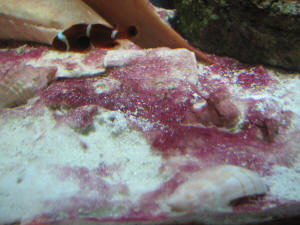
New! FAQ, ID Visual Guide
|
 |
New Print and
eBook on Amazon
Marine Aquarium Algae Control
by Robert (Bob) Fenner
|
|
Help With Picture ID - Nuisance Algae
02/18/2009
Good morning,
<Good morning to you John. Mich with you today.>
I was wondering if I could get advice or help with id a picture
of something growing on my rock.
<Will try!>
When I purchased the live rock from a local store, I asked the
owner for advice on placing the rock in my newly set up tank. I
said to just place the rock in the tank and everything should be
fine.
<Can be the case, but isn't always. More here:
http://www.wetwebmedia.com/estbiofiltmar.htm >
Well now, I am wondering if I made the correct discussion.
<A QT tank can be your friend! More here:
http://www.wetwebmedia.com/quarinverts.htm >
A friend of mine said this was some kind of fungus growing on my
rock and if is from not cleaning the rock before I placed it in
the tank - I don't know.
<This is not a fungus. I suspect it is a nuisance algae that
may have been deprived of light.>
Can you help?
<I hope so!>
Also, can you give me some advice on what to do if it is
fungus?
<Please read here:
http://www.wetwebmedia.com/nutrientcontrol.htm
http://www.wetwebmedia.com/scottsh2ochgart.htm and related links
in blue on the top of the pages.>
Thanks for your help. John
<Welcome! Mich>
75g with total of 115g system. 2x250w MH, 2xVHO, refug has 2xT5,
some SPS, two LPS, and one fish.
|
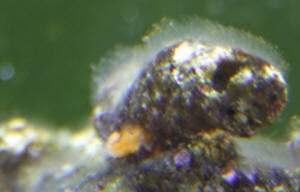 |
|
Nuisance Algae or Sea Fan?? 2/16/09 Hi Crew:
<Hi Bonnie, Mich here.> Attached is a picture that I hope
you can identify. <Me too!> My reef tank is 3 1/2 years
old. I have a deep 5" sandbed made up of crushed coral. I
know, I know.....it takes a bit more maintenance than a substrate
made of true sand, but I am diligent in stirring up the crushed
coral a couple times a week and vacuuming the bed about every 3rd
week. <Good husbandry can makes all the difference!> I
recently removed about an inch of the top substrate and replaced
it with new crushed coral. <You are wise, this will help your
buffering capacity.> After I did this replacement, about 3
weeks later, I noticed this maroon, feathery growth. <May or
may not be related.> It has continued to grow and is quite
pretty. <I agree!> I thought, originally, it must be some
type of sea fan. <Mmm, no.> However, I just want to make
sure and not have some nuisance algae growing and getting out of
control. <Does look like a Rhodophyte to me, but that
certainly doesn't make it a nuisance! If it was mine, I would
encourage it to grow.> It's very soft and feathery. Can
you tell me what this is? <The photo is not clear enough for
me to tell to much beyond it's a red algae, but it sure is a
beauty!> Thanks for your help! <Welcome!>
Bonnie
<Mich>
|
 |
|
Re: Algae ID?! 02/06/09
Hi Minh,
<Hello Brian.>
I apologize! I thought that I had sent you the pics. I did look
on your site (http://www.wetwebmedia.com/trialalgaeid.htm) and a
few you mentioned below but still can't find anything that is
similar to it. Hope these pics are clear enough to get a good
view! Please let me know!
<I'm sorry but I still don't see any attachment with
this email. Could you try to resend the message with the pictures
attached?>
Thanks again for your help!
-Brian
<Cheers, Minh Huynh.>
Re: Algae ID?! 02/06/09
Ugggghh! Very Sorry Minh!
Here are some links to them in case they are getting stripped
off.
http://i258.photobucket.com/albums/hh246/networkfishman/algae%20prob/IMG00030.jpg
http://i258.photobucket.com/albums/hh246/networkfishman/algae%20prob/IMG00031.jpg
http://i258.photobucket.com/albums/hh246/networkfishman/algae%20prob/IMG00033.jpg
Sorry for the inconvenience!! I really apologize!!!
<No problem, Brian. Technology can be so unpredictable. Well,
I am finally able to see this algae and it is quite an
interesting case! If it is indeed a type of algae, I don't
believe I have seen this algal variant before. A typical long and
white algae would be Acanthophora spicifera
(http://www.reeflex.net/tiere/1619_Acanthophora_spicifera%20.htm)
and the growth in your tank is quite different. Another
possibility is a form of sponge like the Carteriospongia
vermifera
(http://www.reeflex.net/tiere/2202_Carteriospongia_vermifera%2002.htm).
I will have to check with my colleagues and other resources to
verify and get back to you.>
Thanks again,
-Brian
<You're welcome. Minh Huynh.><<RMF's
vote's on a Poriferan>>
|
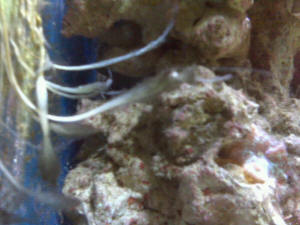 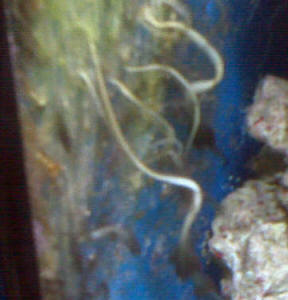 |
|
Re: Algae ID?! 2/13/09
Hi Minh,
<Hello Brian>
Yea, it sure is strange! I'm not sure that it looks like
either one. I'm thinking it looks more like a flat leafy type
of algae as it doesn't resemble any type of sponges I've
seen and the pics of the Acanthophora spicifera seem to be too
spiky / spiny when this looks more feathery (but that could be
due to the high flow area it's in). Someone did mentioned to
me the possibility of Avrainvillea erecta. But I'm not too
sure.
<Don't worry, I haven't forgotten about you. I've
written a colleague about this and I am waiting to hear back from
him.>
I am going to get a SLR camera from a friend and see if I
can't get a really good shot of it. My next email to you will
include the pic as well as my water parameters (which I
conveniently left at home this AM - boo!).
<Excellent, I am looking forward to more photos of this growth
and waiting on your tank water parameters.>
Again... thanks for the help!
-Brian
<You're welcome. Cheers, Minh Huynh.>
|
Algae ID?! 2/5/09
Dear W.W.M Crew!
<Hello Brian. Minh at your service.>
Long time reader, First time writer. Just wanted to give a quick
acknowledgment out to you all; *Thank you* for your great advice and
knowledge sharing!
Well, I found these in my tank a few weeks ago. They started off as
only one and now are multiplying and getting larger. It's a
long-ish wispy looking algae with black fringe but mostly white and
about 3-4 inches long. They seem to attach only to the back glass of my
tank and none of the rocks. I tried many online searches but so far
nothing that really resembles them. I'm thinking it is possibly
some type of Cyano? But am probably wrong.
<Unfortunately, it is difficult to identify a type of algae by
description alone as there are so many variants. It would be ideal if
you could include a photograph for us to reference. However, I do have
some tools for you to use to identify this growth yourself.
First, browse through "The Algae Page"
(http://saltcorner.com/sections/guest/algaepage/algaepage.htm) to see
if you could find a match. This page should have most of the common
algal species found in the marine aquaria. It also contains some
biological remedies as well.
Second, review this excellent article on micro-algal control:
http://www.reefkeeping.com/issues/2008-07/nftt/index.php.
Lastly, a possible match for the growth on your glass could be
dinoflagellates. More information can be viewed here:
http://www.reefkeeping.com/issues/2006-11/rhf/index.php.>
I know my water quality is probably not pristine, but the levels are
constant. My tank is a 72g bow front w/ 20g sump/refug, large Euro-reef
skimmer, and two 150w MH. Bio load shouldn't be an issue as all
fish are fairly small (antenna goby, Rainford's goby, target
mandarin, yellow Coris wrasse, 2 Banggai, 2 blue/green chromis,
hermits, snails) with sps, LPSs, softies, Zoas. I add Reef Builder and
Advantage Calcium two times a week each on different days. I've
asked on some of the different saltwater aquarium forums but
haven't received a good answer, so I'm hoping you all could
help!
<What are your water parameters such as temperature, pH, nitrate,
phosphate, etc?>
Thank you again for the wonderful site and looking forward to your
response!
-Brian from Boston!
<You're welcome. Cheers, Minh Huynh.>
Jelly but not brown? 02/03/09 I have a recurring
problem with a jelly-like substance in my aquarium. I've tried to
research what it might be, and all references I come across are to
brown jelly on hard corals (with the advice to remove it in a hurry).
However, the jelly substance I have is almost clear, not brown; perhaps
a very faint yellowish is best description. <"Brown" jelly
disease doesn't necessarily have to be brown... sometimes it's
clear or beige...> It hasn't grown on any hard coral, though it
has smothered a rock of polyps (despite frequent removal of jelly -
eventually removal of rock and the colony to try to contain this
problem). <This sounds like Cyano or, god forbid, dinoflagellates...
but without a pic, I can't say for sure.> The jelly is present
in a number of areas in the aquarium; it isn't limited to growth on
specimens of any sort. It grows on some tufty algae, has invaded polyp
colonies; can be found on bare but rough rock. High water current
doesn't seem to limit it - there are no visible outbreaks in low
light areas, though (which might just be coincidence). Siphoning off
jelly in gobs is effective as a control, but can't be maintained
long term. I've had the problem for several months, reoccurring in
patches. Removing all rocks and specimens for individual treatment is a
bit of a non starter, as the outbreak of whatever it is isn't
linked to specific rocks or corals. (In fact, it hasn't appeared on
any hard or soft corals, other than a polyp colony and sometimes where
there are encrusting soft corals; my impression is that the infection
isn't linked to these organisms, but they just happen to be there).
<huh> So I'm unclear on what the cause is, or what to do to
treat it. I really need some sort of pan-aquarium treatment rather than
dips (of what I'm unsure), which would cause some massive
disruption. From descriptions of jelly infections I can find, I'm
not convinces this is the same thing as brown jelly (but there again, I
utterly lack experience with this, although I've now kept marines
for over thirty years). The aquarium is 2m long x 60cm square (about
6ft x 18in square) and mature; it is on the first floor with a hole cut
in the floor to a garage below, where an identical aquarium is fitted
with skimmer, heating and so on - so the water volume is quite large -
before being pumped back up. Display tank has good water current and
turnover. SG maintained at 1.025, 25 degrees. Any thoughts on any of
this? Thanks for your time and expertise. <Try keeping the tank in
total darkness for 2 or 3 days. If it's dinoflagellates, this will
help... if not, well, at least it might give us a better idea of what
this might be.> Chris <Best, Sara M.>
|
Black Filamentous "What"
01/31/09
Greetings from a relative newcomer to the field. I have been
watching this "thing" on what I believe to be a
Platygyra. It is black, and getting "longer" all the
time. Very filamentous and feathery in nature. There are now what
appear to be "air bubbles" appearing within the
structure itself....two or three closest to the coral itself, and
two individual "bubbles" equally spaced between there
and where the structure becomes mostly filament. At present it is
approximately 4 to 4.5 inches long and appears to be
"growing".
<It's a kind of Cyanobacteria. In my experience, the type
that grows like this (dark and stringy) is a real pain in the
fins! I'd immediately check your parameters, do a water
change, etc.>
The operative questions are: any idea what it is and if so, is it
desirable, undesirable, or just "there".
<In my experience, in small amounts it's ok. But it can
quickly grow to be a total nightmare.>
Thanks in advance.
Bob Wright
<Best,
Sara M.>
Thanks
|
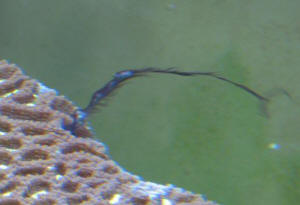 |
|
Re: Black Filamentous "What"
01/31/09
Thanks very much...I check many parameters every other day, and
those I tested are "in the green"...however its been a
week since I checked phosphates. I will "get on it"
before "it" gets on everything else!
<Yeah, it's just a beast! I had it myself once (uh, or
twice) and it can be frustrating when it gets out of hand. It
wouldn't hurt (never does) to run some extra activated carbon
and/or a phosphate sponge...>
Bob
<Best,
Sara M.>
|
Algae ID, Likely Diatoms 1/27/09 Hello crew, <Hi
Mike> I have a 30g tank set up for a month now. For the past week
and a half I have noticed this rust looking algae growing on my live
rock and live sand. It hasn't really been a problem (I can only
assume). Its now spreading all over the in and out takes of my filter
(205 Fluval) and has almost completely covered my power head. I have
looked all over your FAQ's on a bunch of different algae but I
really haven't found one that hits home (sorry I'm more of a
picture type person). The characteristics of it are as follows: On the
sand it looks as if someone dyed it to a rust color, its not hairy or
slimy looking, just a different color. I have 5 Turbos and a sand
sifting star (which eat a lot of it daily). The rock and plastic in the
tank literally look like they're oxidizing, the rock has all
changed color. If I really have stumbled across the right answer then
my assumption would be that its harmless and the bloom will subside
when cycling is done and go away on its own? Now is where my questions
come in. First off could it be that my temperature is too high?
<No.> Its currently 80. I have done a 20% weekly water change and
all my levels are zero. This stuff is growing extremely rapid and im
curious to know if im doing something wrong. If it will subside does
that mean it will go away entirely, if so usually how long after
cycling is complete? <Mike, what you have is a diatom explosion and
is not unusual in new set-ups. Keep up your husbandry and this will
soon go away. See the link here and I'm sure the pics you see will
be similar to what your are seeing in your tank.
http://saltaquarium.about.com/cs/algaecontrol/l/blpicalgaediato.htm>
I forgot to add I currently do not have a protein skimmer (I bought a
cheap one and it makes way too many micro bubbles, everything I have
done to get rid of them ended in disaster so out it went.) would this
have any effect on algae? <On algae, oh yes. An efficient protein
skimmer is one of the best investments you can make to improve water
quality.> Thanks <You're welcome. James (Salty Dog)>
-Mike
|
Slime Algae 1/18/09
Hello, I have spent hours reading on your website it is
great.
<Awesome.>
I have a 55gal garden reef , 10gal refugium, cpr wet/dry with
built in skimmer. The uv sterilizer and carbon only once or twice
a month. For lighting I run a 8 bulb 432watt t5 light for 8 hours
a day 2 hours of actinic before and after the 8 hour period. My
water parameters seem to be right ph 8.3 calcium 400, magnesium
1300, nitrites, nitrates, ammonia and phosphate all at 0. I have
been having a problem with some type of slime covering
everything, I have scrubbed it off several times. I have three
400gph Hydor Koralia for water movement with 500gph return pump.
My sand bed is only about 2-3 inches deep and gets stirred up by
my clownfish a lot I was thinking maybe this was causing the
problem but I wanted to ask the pros.
<Crud on the sandbed is indicative of other issues, but for
what it is worth this really should be increased to 4-5' for
a true DSB or reduced to 1' or less for cleaning. The middle
ground tends to accumulate detritus and nutrients without any
benefit.>
I have 5 SPS's, frog spawn, elephant ear mushroom, brain
coral, crocea clam and several trumpet corals. My refugia has
Caulerpa and Halimeda plant in it. I have a sebae clownfish,
tomini tang and a damsel. I do 5 gal water changes every week.
Sometimes when the sand gets stirred up I can see black spots in
it when you stir the black spot up its like dust. I have included
a photo of the slime.
<BGA.>
I appreciate you taking the time to read this and any suggestions
on what to do to get rid of this or maybe just what it is would
be great.
<The fueling factors are introduced somewhere, either feeding
or source water. Your levels test OK because they are being
consumed as produced. Do see
http://www.wetwebmedia.com/bluegralgae.htm and the linked files
above. All the solutions to your issue are held there
within.>
Thanks for the help and such a great website Dan
|
[1]%20slime%20alg.JPG) |
|
Hey Crew
Re: Neglected tank, algae run a muck 1/4/09
I have been looking on your web site all day, and found a wealth
of information, however, not quite what I am looking for. I have
a 75 gallon reef with a good amount of live rock. It has been set
up for 5 or 6 years.
I went through a period when I didn't take care of it the way
I should have and I have an algae problem. I also have a 20
gallon refugium with Caulerpa, and I can't remember what the
other stuff is in there. I think it is Chaeto.
<Most likely Chaeto if it looks like green spaghetti. Do be
careful with the Caulerpa though. It's one nasty bugger if it
goes sexual on you or gets in your main display. Here's some
information to ID if you have time
http://www.sccat.net/#identification-1e86f5>
I have some hair algae in the refugium also, but that is not may
main concern. In the display tank there is a brush like growth
that I think is Chlorodesmis, based on the pictures I can
find.
<A picture would be best to see here, but I have doubts that
you are dealing with Chlorodesmis aka maidens hair algae.>
I have read that it is a difficult algae to grow, so I am not
sure that is it. It will grow Large clumps in my display tank. I
have tried to manually remove as much as I can, and have started
keeping the tank better, keeping the water quality up, cleaning,
watching the chemistry. But the algae seems to still grow
abundantly. It grows so thick that it traps solid waste near the
rock it grows on and acts like "potting soil". The only
think I am not totally sure about is the phosphate level. I have
trouble distinguishing the color on the test kits. The other
levels test 0 for ammonia nitrate and nitrite. I know from other
articles that there could still be some level in the tank, but it
gets used quickly enough so it doesn't show up on a test.
I am wondering it there is something I can put in the tank to
control this stuff. I have a candy coral that I had to separate
into smaller pieces to remove some on the algae that was killing
a portion of the coral.
Thanks for any input you can give me.
<Again, without a picture it is hard to say, but if it looks
like maidens hair, I would think it is probably Bryopsis or hair
algae. Bryopsis can look like ferns or more like hair algae with
tiny hairs growing off the central hair shaft. Its very hard to
get rid of. There are a few things you can do if it is Bryopsis.
I've heard of a few things that work most of the time, and
only one that works all of the time. Ruby lettuce Nudi's will
eat it all, but then you must take care that they don't
starve and either return them to the local fish store or pass
them along to someone else in town who has an algae problem. You
must also be careful of powerheads because they will enter them
and get ripped apart. I've also heard that raising magnesium
works, but it is hit or miss. You can find some more information
on the subject here:
Algae control in general
http://www.wetwebmedia.com/algaeconMar.htm
Specifics on Bryopsis
http://fish.suite101.com/article.cfm/bryopsis_a_common_pest_in_aquaria
Regards, Jessy>
Kelley
|
re: Hey Crew 1/4/09
Here are a couple of pictures to help with ID.
I don't see anything that looks remotely like something coming
off the main shaft.
Kelley
<Mmm, looks like Bryopsis sp. to me... a tough Green algae to
control...
See the Net, WWM re probable approaches. Bob Fenner> |
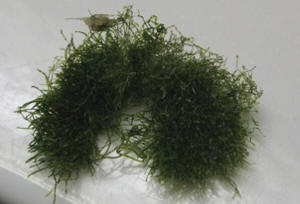 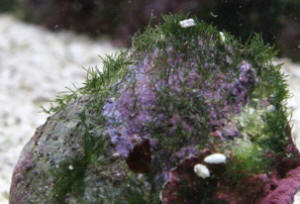 |
|
Red algae growth... BGA, reading 12/26/08 Hi
there. I've been battling some type of red algae growth in my
tank over the last few weeks and would like to know if it is
harmful or not. <Can be> If so, what measures should I take
to get rid of it? <A few approaches...> Even if it's
not, how could I control it? It quickly spreads over all the
substrate of the tank as well as the live rock. I tried to
identify it using the pictures on this site but couldn't find
anything that looked like a perfect match. The algae will peel up
in sheets off the substrate once it has grown for a little while.
Here's a picture of it after about a week and a half after I
cleaned it up last: >... is BGA, aka Cyanobacteria. Read here:
http://wetwebmedia.com/bluegralgae.htm and the linked files
above. Bob Fenner>
|
 |
| Thanks so much for the help! All I needed was a definitive ID
on that stuff. <Ahh, welcome... Not hard to "nip in the
bud" when caught early on... Good luck. B> |
 |
New Print and
eBook on Amazon
Marine Aquarium Algae Control
by Robert (Bob) Fenner
|
|
|

